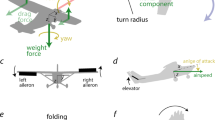Abstract
In this work, how a small bird (Japanese White-eye, Zosterops japonicus) executes a sharp turning maneuver is analyzed from a mechanical perspective. A specific type of turning maneuver, termed a ‘hovering turn’, was experimentally identified, which is evidently distinct from the yaw or bank turn that is well documented in the literature. The hovering turn is characterized by a turning radius only about ~1/10 of the wingspan, and requires less than 0.2 s. The reorientation of the bird’s body is invariably preceded by a brief hovering stage during which the elevation angle of the bird increases from 40° to approximately 90°, leading beneficially to a considerable decrease (40% of its maximum) in the moment of inertia of the body against the axis of rotation. The brief hovering is deemed a strategic, preparatory and transitional stage in executing a roll-dominated turn that is efficient and particularly suitable for a small space. The mechanisms pertaining to the hovering turn might provide a useful, biomechanical inspiration to improve the maneuverability of artificial aerial vehicles.












Similar content being viewed by others
References
Sudo S, Tsuyuki K, Kanno K (2005) Wing characteristics and flapping behavior of flying Insects. Exp Mech 45(6):550–555
Eloy C, Doare O, Duchemin L, Schouveiler L (2010) A unified introduction to fluid mechanics of flying and swimming at high Reynolds number. Exp Mech 50(9):1361–1366
Hedrick TL, Biewener AA (2007) Low speed maneuvering flight of the rose-breasted cockatoo (eolophus roseicapillus). I. Kinematic and neuromuscular control of turning. J Exp Biol 210(11):1897–1911
Norberg UM (1990) Vertebrate flight: mechanics, physiology, morphology, ecology and evolution. Zoophysiology, vol 27. Springer, Berlin
Stolpe VM, Zimmer K (1939) Der schwirrflug des kolibri im zeitlupenfilm. J Ornithol 87:136–155
Evans MR, Thomas ALR (1992) The aerodynamic and mechanical effects of elongated tails in the scarlet-tufted malachite sunbird—measuring the cost of a handicap. Anim Behav 43(2):337–347
Norberg UM (1976) Aerodynamics of hovering flight in long-eared bat plecotus-auritus. J Exp Biol 65(2):459–470
Warrick DR, Tobalske BW, Powers DR (2005) Aerodynamics of the hovering hummingbird. Nature 435(7045):1094–1097
Tobalske B, Warrick D, Dickson W, Altshuler D, Dickinson M (2007) Hovering aerodynamics in hummingbirds: comparing a dynamically-scaled robot with live birds. Comp Biochem Physiol Mol Integr Physiol 146(4):S115–S116
Schroeder TP, Powers DR, Wethington SM, Tobalske BW (2009) Hovering flight performance in captive and free-living hummingbirds. Integr Comp Biol 49:E302–E302
Warrick DR, Tobalske BW, Powers DR (2004) Kinematic symmetry and aerodynamic asymmetry in the hovering flight of hummingbirds. Integr Comp Biol 44(6):661–661
Tobalske BW, Warrick DR (2009) Where’s the lev? aerodynamics of the hummingbird wing during hovering. Integr Comp Biol 49:E171–E171
Warrick DR, Dial KP, Biewener AA (1998) Asymmetrical force production in the maneuvering flight of pigeons. Auk 115(4):916–928
Warrick DR, Dial KP (1998) Kinematic, aerodynamic and anatomical mechanisms in the slow, maneuvering flight of pigeons. J Exp Biol 201(5):655–672
Hedrick TL, Cheng B, Deng XY (2009) Wingbeat time and the scaling of passive rotational damping in flapping flight. Science 324(5924):252–255
Iriarte-Diaz J, Swartz SM (2008) Kinematics of slow turn maneuvering in the fruit bat cynopterus brachyotis. J Exp Biol 211(21):3478–3489
Hedrick TL, Usherwood JR, Biewener AA (2007) Low speed maneuvering flight of the rose-breasted cockatoo (eolophus roseicapillus). II. Inertial and aerodynamic reorientation. J Exp Biol 210(11):1912–1924
Videler JJ (2005) Avian flight. Oxford ornithology series, vol 14. Oxford University Press, Oxford
Thomas ALR, Taylor GK (2001) Animal flight dynamics I. Stability in gliding flight. J Theor Biol 212(3):399–424
Tobalske BW, Hedrick TL, Biewener AA (2003) Wing kinematics of avian flight across speeds. J Avian Biol 34(2):177–184
Ting SC, Yang JT (2008) Pitching stabilization via caudal fin-wave propagation in a forward-sinking parrot cichlid (cichlasoma citrinellum x cichlasoma synspilum). J Exp Biol 211(19):3147–3159
Ting SC, Yang JT (2009) An innovative technique for simultaneous measurement of three-dimensional kinematics and induced flow of a swimming fish. J Mech 25(4):355–362
Gander W, Golub GH, Strebel R (1994) Least-squares fitting of circles and ellipses. BIT 34(4):558–578
Dudley R (2002) Mechanisms and implications of animal flight maneuverability. Integr Comp Biol 42(1):135–140
Tobalske BW, Dial KP (1996) Flight kinematics of black-billed magpies and pigeons over a wide range of speeds. J Exp Biol 199(2):263–280
Pennycuick CJ (1996) Wingbeat frequency of birds in steady cruising flight: new data and improved predictions. J Exp Biol 199(7):1613–1618
Frohlich C (1980) Physics of somersaulting and twisting. Sci Am 242(3):155
Acknowledgement
National Science Council of the Republic of China partially supported this work under contract numbers NSC 96-2628-E-002-256-MY3, NSC 96-2628-E-002-258-MY3 and NSC99-2218-E007-002.. We thank Yu-Hung Chang for assisting in conduct of experiments and analysis of data. We thank editors and three reviewers for their helpful comments on this paper.
Author information
Authors and Affiliations
Corresponding author
Rights and permissions
About this article
Cite this article
Su, JY., Ting, SC. & Yang, JT. How a Small Bird Executes a Sharp Turning Maneuver: A Mechanical Perspective. Exp Mech 52, 693–703 (2012). https://doi.org/10.1007/s11340-011-9537-5
Received:
Accepted:
Published:
Issue Date:
DOI: https://doi.org/10.1007/s11340-011-9537-5




